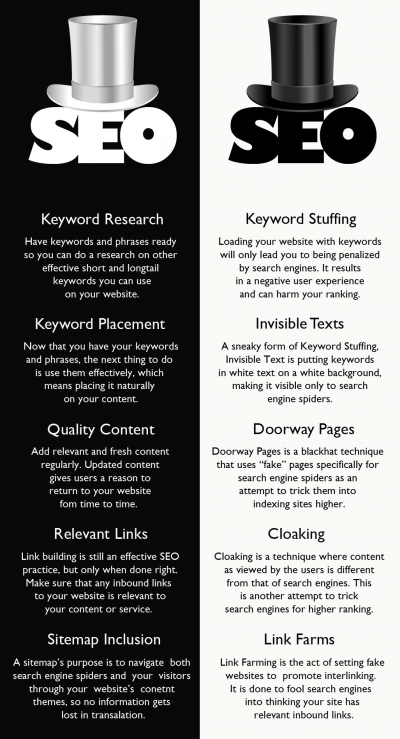In the prehistoric days of the Internet, all websites were simple pages built with HTML, which is basically just text with a few symbols thrown in, and good website copywriting wasn’t as important as it is today.
Around the time that most of us started getting AOL CDs in the mail, there were only around 100,000 websites in existence. Back then, searching through them was done with Yahoo! Search, AltaVista, Lycos, Hotbot and, eventually, Google. These search engines usually used a human-submitted directory, until Google became the clear winner by relying on “backlinks” to rank sites by how much “authority” they had.

Black Hats and SEO
There are now over 1 billion websites on the Internet, and most are no longer built with HTML. As the Internet started growing faster and faster, some people tried to game the system and get to the top of Google by using what is known as “black hat” SEO (after the bad guys in Western films who always wore black cowboy hats).
One of the very first black hat strategies was to use Google’s authority system against itself. Website creators would build “link farms,” hundreds of websites linking back to a single page that made that page appear to have hundreds of backlinks and thus tonnes of authority.
Google also used to rely heavily on meta tags and keywords. The meta description and title tags are still important, but in the old days you could have a page with hundreds of unrelated keywords and hope anyone searching for any one of them would accidentally arrive on your page. Keywords could be stuffed into image descriptions, and crammed at the bottom of pages in the text. No longer.
Today, Google uses a sophisticated and constantly changing algorithm that beats black hat SEO and rewards sites with “good” content and punishes sites without it. This algorithm still combines meta tags, backlinks, and a lot of other factors, but today, Google has the ability to judge the quality of your content with a lot of accuracy.
Since at least 89% of consumers use a search engine to find products, and at least 80% of people use Google as their search engine, what Google thinks about your website is really important for your business.
What is good website content?
- Good website content is original. Google ignores pages that have words that are repeated elsewhere on the Internet. This means it knows if your page is a duplicate of something else.
- Good website content doesn’t send you somewhere else. Adding too many links to other websites just tells Google that your content isn’t quite good enough to stand on its own.
- Good website content provides a lot of good information. If there’s nothing on the page, Google ignores it – this includes pages that are solely images. If your images don’t have descriptions and there is no text introduction, it will be tough for Google to even find it.
- Good website content gets straight to the point. Splash pages, entry pages and other delays to the real content can cause an entire website to be ignored.
- Good website content doesn’t have a lot of nonsense keywords. Filling your page with lists of words will just hurt your ranking. Google can tell the difference between a paragraph that makes sense and a list of keywords.
Google is continuously using human editors to create better and better content quality guidelines so it can update its algorithm. There is actually a secret document created by these humans, but from time to time it has been leaked and the guidelines are surprisingly common sense.
Good website content should be written at an expert level, with a satisfying amount of information, include some co-citation, be fresh and include contact information. Does this sound a little vague? It is, but these are the same guidelines that magazines or any other professional publication require from their writers.

What do these good content guidelines mean for the business owner?
Many business owners still assume that throwing a few bits of information on a website and throwing out a blog post now and then will bring them web traffic. The mantra is “If we build it, they will come.” That’s just not true anymore.
If a business isn’t getting website traffic and sales leads aren’t coming from the Internet, the issue isn’t the audience – it’s the content! Not only does a website need to look good (which is totally possible for little money nowadays), the content needs to have the professional polish of a really good copywriter – not just to impress Google, but to impress and persuade potential customers!
Although there are many multi-talented business owners out there who can write great content, the question remains: why try to write it yourself when there are amazing professional copywriters who know exactly how to attract clients AND optimize your high-quality content for a better Google ranking? A good copywriter is not only able to create pages describing your product or service, but also do the research and create informative articles that answer your customer’s questions and always highlight the benefits of what you offer.
The major task in every sales pitch is the process of client education and addressing concerns. If your website has already done half the work by being the authoritative source of information on your area of expertise, closing the deal is just that much easier (and probably cheaper!).
Want to find out more about professional website copywriting? Click here to ask us anything!




